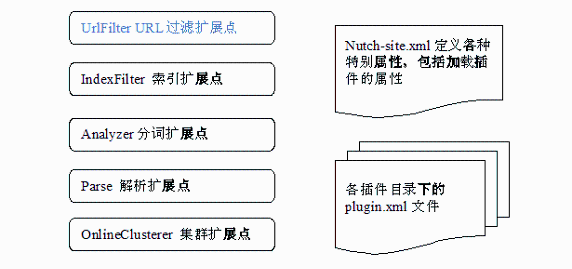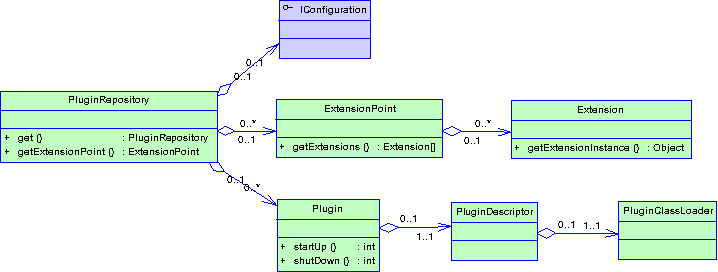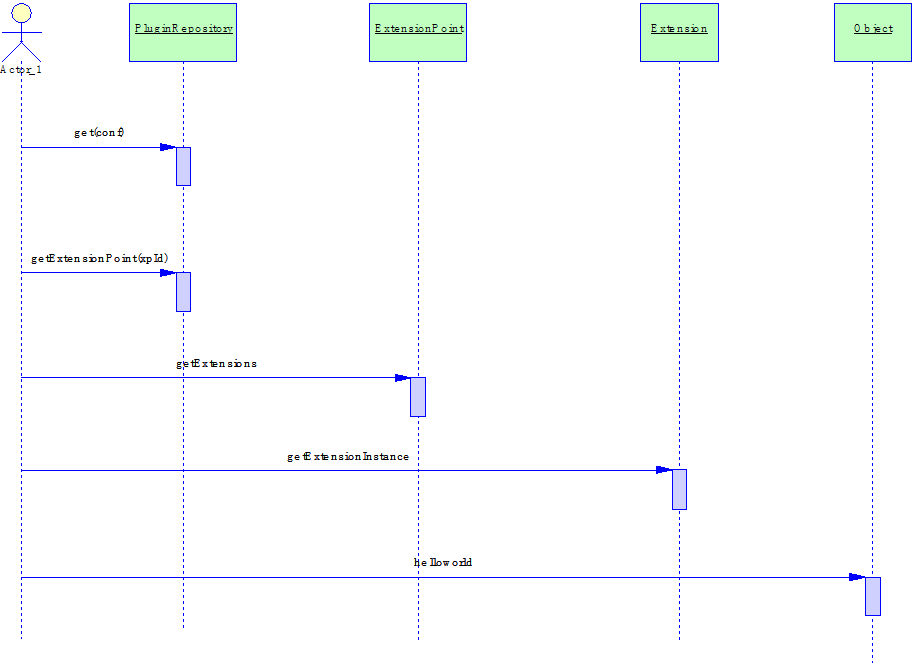标签:
nutch系统架构的一个亮点就是插件,借鉴这个架构我们可以设计出自己的灵活的系统架构下面就来解析Nutch的插件系统是怎么回事。
关于nutch,在这里了解:http://nutch.apache.org,目前最新版本是1.10:
Nutch is a well matured, production ready Web crawler. Nutch 1.x enables fine grained configuration, relying on Apache Hadoop? data structures, which are great for batch processing.
1、扩展点(ExtensionPoint )
扩展点是系统中可以被再次扩展的类或者接口,通过扩展点的定义,可以使得系统的执行过程变得可插入,可任意变化。
2、扩展 ( Extension )
扩展式插件内部的一个属性,一个扩展是针对某个扩展点的一个实现,每个扩展都可以有自己的额外属性,用于在同一个扩展点实现之间进行区分。扩展必须在插件内部进行定义。
3、插件 ( Plugin )
插件实际就是一个虚拟的容器,包含了多个扩展 Extension、依赖插件 RequirePlugins 和自身发布的库Runtime,插件可以被启动或者停止。
Nutch 为了扩展,预留了很多扩展点 ExtenstionPoint,同时提供了这些扩展点的基本实现 Extension,Plugin
用来组织这些扩展,这些都通过配置文件进行控制,主要的配置文件包括了多个定义扩展点和插件(扩展)的配置文件,一个控制加载哪些插件的配置文件。体系结构图如下:

1. runtime 属性描述了其需要的 Jar 包,和发布的 Jar 包
2. requires 属性描述了依赖的插件
3. extension-point 描述了本插件宣布可扩展的扩展点
4. extension 属性则描述了扩展点的实现
<plugin id="urlfilter-suffix" 插件ID name="Suffix URL Filter" 插件名称 version="1.0.0" 插件版本 provider-name="nutch.org"> 插件提供者的ID <runtime> <library name="urlfilter-suffix.jar"> 依赖的JAR包 <export name="*"/> 发布的JAR包 </library> </runtime> <requires> <import plugin="nutch-extensionpoints"/> 依赖的插件 </requires> <extension id="org.apache.nutch.net.urlfilter.suffix" 扩展的插件ID name="Nutch Suffix URL Filter" 扩展的插件名 point="org.apache.nutch.net.URLFilter"> 插件的扩展点ID <implementation id="SuffixURLFilter" 插件实现ID class="org.apache.nutch.urlfilter.suffix.SuffixURLFilter"/> 实现类 <!-- by default, attribute "file" is undefined, to keep classic behavior. <implementation id="SuffixURLFilter" class="org.apache.nutch.net.SuffixURLFilter"> <parameter name="file" value="urlfilter-suffix.txt"/> </implementation> --> </extension> </plugin>
<!-- plugin properties --> // 插件所在的目录,缺省位置在 plugins 目录下。 <property> <name>plugin.folders</name> <value>plugins</value> <description>Directories where nutch plugins are located. Each element may be a relative or absolute path. If absolute, it is used as is. If relative, it is searched for on the classpath.</description> </property> // 当被配置为过滤(即不加载),但是又被其他插件依赖的时候,是否自动启动,缺省为 true。 <property> <name>plugin.auto-activation</name> <value>true</value> <description>Defines if some plugins that are not activated regarding the plugin.includes and plugin.excludes properties must be automaticaly activated if they are needed by some actived plugins. </description> </property> // 要包含的插件名称列表,支持正则表达式方式定义。 <property> <name>plugin.includes</name> <value>protocol-http|urlfilter-regex|parse-(text|html|js)|index-(basic|anchor)|query- (basic|site|url)|response-(json|xml)|summary-basic|scoring-opic|urlnormalizer-(pass|regex|basic) </value> <description>Regular expression naming plugin directory names to include. Any plugin not matching this expression is excluded. In any case you need at least include the nutch-extensionpoints plugin. By default Nutch includes crawling just HTML and plain text via HTTP, and basic indexing and search plugins. In order to use HTTPS please enable protocol-httpclient, but be aware of possible intermittent problems with the underlying commons-httpclient library. </description> </property> // 要排除的插件名称列表,支持正则表达式方式定义。 <property> <name>plugin.excludes</name> <value></value> <description>Regular expression naming plugin directory names to exclude. </description> </property>

类包括:
1. PluginRepository 是一个通过加载 Iconfiguration 配置信息初始化的插件库,里面维护了系统中所有的扩展
点 ExtensionPoint 和所有的插件 Plugin 实例
2. ExtensionPoint 是一个扩展点,通过扩展点的定义,插件 Plugin 才能定义实际的扩展 Extension,从而实现
扩展,每个 ExtensionPoint 类实例都维护了宣布实现了此扩展点的扩展 Extension.
3. Plugin 是一个虚拟的组织,提供了一个启动 start 和一个 shutdown 方法,从而实现了插件的启动和停止,
他还有一个描述对象 PluginDescriptor,负责保存此插件相关的配置信息,另外还有一个 PluginClassLoader 负责此插件相关类和库的加载。

通过序列图可以发现,Nutch 加载插件的过程需要 actor 全程直接调用每个关联对象,最终得到的是插件的实现对象。详细过程如下:
1. 首先通过 PluginRepository.getConf() 方法加载配置信息,配置的内容包括插件的目录,插件的配置文件信息 plugin.properties 等,此时 pluginrepository 将根据配置信息加载各个插件的 plugin.xml,同时根据 Plugin.xml 加载插件的依赖类。
2. 当 actor 需要加载某个扩展点的插件的时候,他可以:
1. 首先根据扩展点的名称,通过 PluginRepository 得到扩展点的实例,即 ExtensionPoint 类的实例;
2. 然后调用 ExtensionPoint 对象的 getExtensions 方法,返回的是实现此扩展点的实例列表
(Extension[]);
3. 对每个实现的扩展实例 Extension,调用它的 getExtensionInstance() 方法,以得到实际的实现类实
例,此处为 Object;
4. 根据实际情况,将 Object 转型为实际的类对象类型,然后调用它们的实现方法,例如 helloworld 方法。
private Extension findExtension(String name) throws PluginRuntimeException {
Extension[] extensions = this.extensionPoint.getExtensions();
for (int i = 0; i < extensions.length; i++) {
Extension extension = extensions[i];
if (contains(name, extension.getAttribute("protocolName")))
return extension;
}
return null;
}
boolean contains(String what, String where){
String parts[]=where.split("[, ]");
for(int i=0;i<parts.length;i++) {
if(parts[i].equals(what)) return true;
}
return false;
}
实际整个系统如果使用了插件架构,则插件类的加载是由 PluginClassLoader 类完成的,每个 Plugin 都有自己的 classLoader,此 classloader 继承自 URLClassLoader,并没有做任何事情:
public class PluginClassLoader extends URLClassLoader {
/**
* Construtor
*
* @param urls
* Array of urls with own libraries and all exported libraries of
* plugins that are required to this plugin
* @param parent
*/
public PluginClassLoader(URL[] urls, ClassLoader parent) {
super(urls, parent);
}
}
这个 classloader 是属于这个插件的,它只负责加载本插件相关的类、本地库和依赖插件的发布 (exported) 库,也包括一些基本的配置文件例如 .properties 文件。
此类的实例化过程:
/**
* Returns a cached classloader for a plugin. Until classloader creation all
* needed libraries are collected. A classloader use as first the plugins own
* libraries and add then all exported libraries of dependend plugins.
*
* @return PluginClassLoader the classloader for the plugin
*/
public PluginClassLoader getClassLoader() {
if (fClassLoader != null)
return fClassLoader;
ArrayList<URL> arrayList = new ArrayList<URL>();
arrayList.addAll(fExportedLibs);
arrayList.addAll(fNotExportedLibs);
arrayList.addAll(getDependencyLibs());
File file = new File(getPluginPath());
try {
for (File file2 : file.listFiles()) {
if (file2.getAbsolutePath().endsWith("properties"))
arrayList.add(file2.getParentFile().toURL());
}
} catch (MalformedURLException e) {
LOG.debug(getPluginId() + " " + e.toString());
}
URL[] urls = arrayList.toArray(new URL[arrayList.size()]);
fClassLoader = new PluginClassLoader(urls, PluginDescriptor.class
.getClassLoader());
return fClassLoader;
}
* 首先判断缓存是否存在
* 加载需要的 Jar 包、自身需要的 Jar 包,依赖插件发布的 Jar 包
* 加载本地的 properties 文件
* 构造此 classloader,父 classloader 为 PluginDescriptor 的加载者,通常是 contextClassLoader
Nutch 是一个非常出色的开源搜索框架,它的插件架构更加是它的一个技术亮点,通过此架构,可以保证 Nutch方便的被灵活的扩展而不用修改原来的代码,通过配置文件可以简单方便的控制加载或者不加载哪些插件,而且这些都不需要额外的容器支持。这些都是我们在系统架构设计的时候可以学习和参考的有益经验。
标签:
原文地址:http://my.oschina.net/cloudcoder/blog/473304